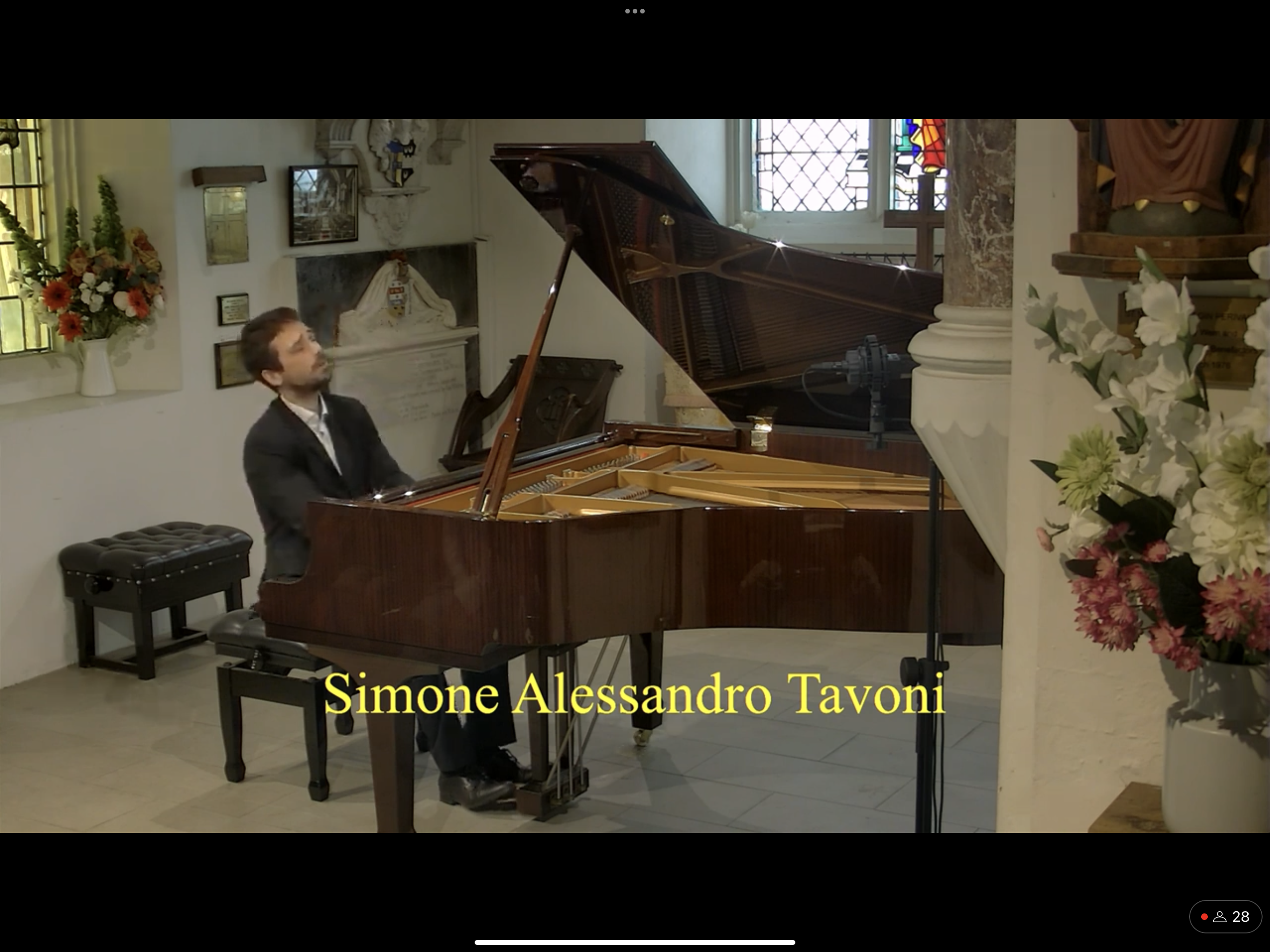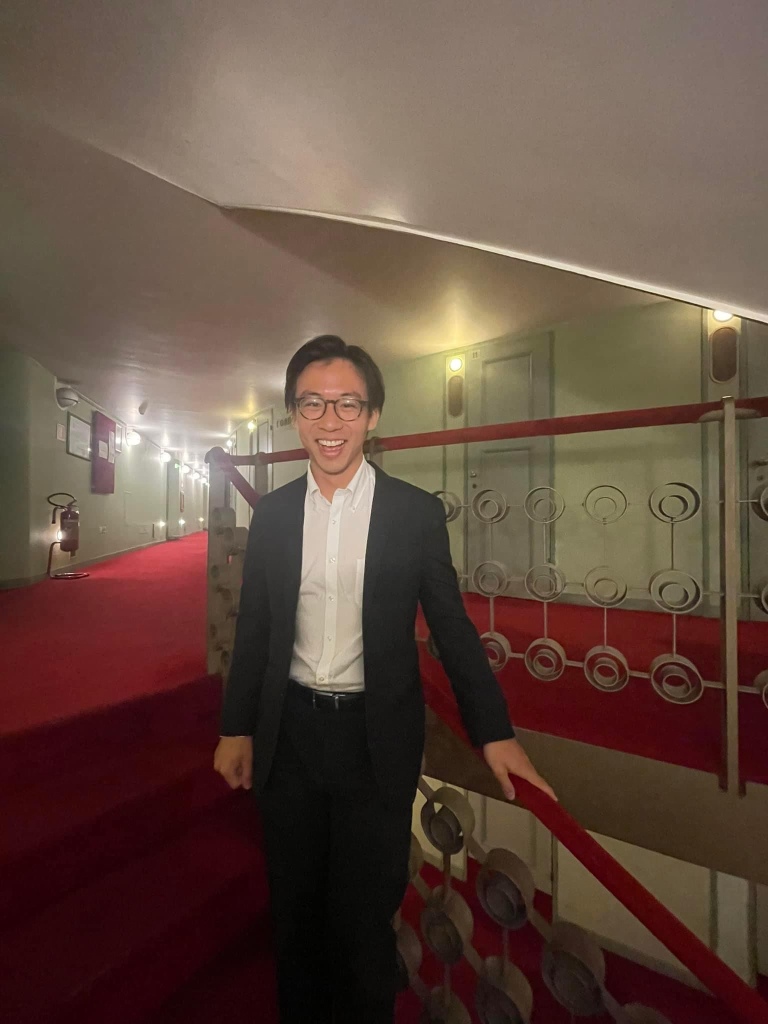Thursday 29 June 3.00 pm


A beautiful programme played with simplicity,sensitivity and intelligence.It was the hallmark of Simone Tavoni’s programme that he had dedicated to the memory of Radu Lupu a few months ago at Leighton House.It was in 1969 that Radu Lupu had shown us the beauty of Schubert when played with simplicity and a kaleidoscopic range of sounds that we had never heard the like of before.It was the same dedicated musicianship that was to be revealed again in Leeds three years later when Murray Perahia astounded a jury of celebrated pianists with a miraculous performance of the Sonata op 106 by Mendelssohn.These two great musicians fast became friends and their recording of Schubert F minor Fantasy is one of the wonders of our age.Simone had chosen a programme that was a continuous outpouring of song which was so much part of Radu Lupu’s ever more intimate musicianship.

What better work to choose than the ‘little’A major Sonata by Schubert ( Lupu in Leeds had chosen the ‘little’A minor Sonata in the first round).One of the shortest of Schubert’s Sonatas with a lyricism from the first to the last note where the ‘sturm und drang’ of the age had been translated into a pastoral outpouring of simple beauty.There was timeless lyricism to the opening in Simone’s performance and although he did not have the sound palette of Lupu (that was more of Richter than of Solomon) there was a beautiful fluidity and simple intelligent musicianship to all he did.Even the strident question and answer of octaves was incorporated into an architectural line that made such sense and never disturbed the musical flow for a show of empty virtuosity.The Andante was profoundly expressive but with a luminosity of sound that allowed the music to speak with such disarming simplicity.The Allegretto had great rhythmic energy and a ‘joie de vivre’ that was indeed exhilarating.A performance where the music was allowed to speak for itself played with a technical command of art that conceals art.

Simone is right when he says that Mendelssohn is unjustly neglected in concert programmes.I remember Perahia’s mentor Rudolf Serkin playing Mendelssohn’s Preludes and Fugues in a programme that included Reger and late Beethoven.The ‘Songs without Words’ where Mendelssohn’s seeming endless melodic outpourings are every bit as astonishing as Schuberts.A different period of course where ‘heart on sleeve ‘ sentiments were more easily expressed but if played with an aristocratic sense of style allowing the music to unfold naturally can reveal gems of ravishing beauty and astonishing musical invention.It was just this beauty that Simone was able to share with us today with his choice of five contrasting ‘Songs’.The first with its long outpouring and the beauty of the melodic line.And how magically he added the chiming bell in the distance over the continuing melodic line.The contrast of staccato and legato in the second although not as teasing as in the hands of Horowitz or Davis was played with exemplary charm and grace.The third one revealed a magical unfolding of the melodic line of fragmented mellifluous invention.The unashamedly sentimental outpouring of the fourth was played with aristocratic simplicity allowing the music to unfold so naturally with a supremely stylish ending.The last one,as Simone had told us,was written in London,and was a Brahmsian outpouring of fervent longing and touching nostalgia.

The Albeniz too was beautifully lyrical with the Barcarolle with its unmistakably Spanish idiom.The doubling of the melodic line in the lyrical middle episode was played with great sweep and contrasted with the magical atmosphere of the final arabesques.Almeria flowed so eloquently with its pungent expressive harmonies leading to the bass melodic line and strumming of guitars.A misty atmosphere of excitement disappearing to a distant memory of chiselled beauty.

Brahms was played with passion and dynamic drive but also with intelligence and a sense of orchestral colour.There was excitement and grandeur and also deep brooding of mounting passion and drive.I have heard Simone play these two Rhapsodies on other occasions but today he played with great authority and an involvement that was totally convincing.A beautiful programme played with beauty,simplicity and authority but above all with intelligence and great artistry.The encore of a Sonata by Clementi was played with a playful charm and beguiling sense of ease that was an ideal way to close such an enjoyable recital.
Simone Tavoni at Livorno Classica flying high with poetic reasoning and with Dinosaurs overhead

Simone Alessandro Tavoni has given recitals internationally across Europe and U.S in venue such the Purcell room, Wigmore Hall, Royal Festival Hall, St Martin in the FieldsSt.John’s Smith Square, Steinway Hall, St.Mary Perivale in London , Liszt Museum in Budapest, Palau de la MusicaCatalana in Barcelona, the Aarhus concert hall, The Tallin Philarmonia ( Estonia ) and the Florence Conservatory hall. In 2019, Simone has been selected as a Parklane Group Artist, as Keyboard Charitable Trust Artist and received the Luciano and Giancarla Berti full-ride scholarship to attend the Aspen Music Festival and School studying with renowned professor Fabio Bidini. Graduated at Royal College of Music with professor Andrew Ball, and Simone has recently attained an Artist Diploma at Trinity Laban Conservatoire with professors Deniz Gelenbe and Peter Tuite. He began his musical education in Italy with professor Marco Podesta’ and pursue his studies at the Liszt Academy of Budapest with Dr.Kecskes Balazs and in Germany at the Hochschule fur Musik un Darstellende of Stuttgart with Dr,Peter Nagy. In 2016 was selected for the BBC pathway scheme and he is a fellow at the Aspen Music Festival and School. He is generously assisted by HSH Dr.Donatus Prince of Hohenzollern.
Simone Tavoni in Viterbo a recital of poetic sensitivity and intelligence
Simone Tavoni triumphs on the Italian tour for the Keyboard Trust – part 1 Florence – part 2 Venice and Padua
Simone Tavoni a Poet speaks at the 1901Arts Club

‘Several people assured me that under my hands the keys become singing voices, which, if it is true, pleases me very much, because I cannot abide the accursed hacking which is a characteristic even of first-class pianists, as it pleases neither the ear nor the spirit.‘ Franz Schubert
The Sonata in A major, D664 was in all likelihood the work which Schubert’s civil-servant friend Albert Stadler remembered many years later as having been written in the summer of 1819 for Josefa von Koller, the daughter of a wealthy iron merchant, during the composer’s first visit to the town of Steyr, in Upper Austria, in the company of the famous baritone Johann Michael Vogl. ‘Yesterday … a very violent thunderstorm broke out in Steyr, killing a young girl and injuring two men in the arm’, Schubert told his brother Ferdinand at the time. ‘In the house where I’m staying there are eight girls, almost all pretty. You can see we’re kept busy. The daughter of Herr v. Koller, at whose house I and Vogl eat every day, is very pretty, plays the piano well, and is going to sing several of my songs.’The Little” A major sonata is so called to distinguish it from the 1828 penultimate sonata in the same key and is the shortest among Schubert’s complete sonatas.The manuscript, completed in July 1819, was dedicated to Josephine von Koller of Steyr in Upper Austria, whom he considered to be “very pretty” and “a good pianist”. The lyrical, buoyant, in spots typically poignant nature of this sonata fits the image of a young Schubert in love, living in a summery Austrian countryside, which he also considered to be “unimaginably lovely”

The Rhapsodies, Op. 79 were written in 1879 during Brahms’summer stay in Portschach when he had reached the maturity of his career. They were inscribed to his friend, the musician and composer Elisabeth von Herzogenberg.At the suggestion of the dedicatee, Brahms reluctantly renamed the sophisticated compositions from “Klavierstücke” (piano pieces) to “rhapsodies”Brahms’ “Rhapsodies” op. 79 written more than a quarter-century after his three piano sonatas are among his most frequently played works. He had a hard time finding a suitable title for them, vacillating between “Piano Piece”, “Capriccio” (No. 1) and ”Caprices”. His hand was forced by the dedicatee Elisabeth von Herzogenberg, who welcomed the pieces with the salutation “Ye (to me) nameless ones in the nebulous garb of rhapsodies”.

The eight volumes of Songs Without Words, each consisting of six songs were written at various points throughout Mendelssohn’s life between 1829 and 1845 and were published separately. The piano became increasingly popular in Europe during the early nineteenth century, when it became a standard item in many middle-class households.Many of the ‘songs’ are within the grasp of pianists of various abilities and this undoubtedly contributed to their popularity. The title Song Without Words seems to have been Felix Mendelssohn’s own invention. In 1828 his sister ,Fanny wrote in a letter “My birthday was celebrated very nicely … Felix has given me a ‘song without words’ for my album (he has lately written several beautiful ones).”

Mallorca ‘Barcarola’, Op 202, was written in London in 1890. Albeniz’s performances were very well received in Britain where in 1890 he did an extensive concert tour there. The barcarolle is usually associated with the soothing stroke of the Venetian gondoliers, or the rocking motion of lullabies; however, the barcarola of Albéniz’s Mallorca refers to a style of lament, particular to the island of Mallorca, which is sung by one grieving the loss of a fiancé who has died.Although Albéniz did not write a single piece for the guitar, a great number of his works, originally composed for the piano, were taken up and transcribed by guitarists almost immediately after they were written, and they have remained an important part of the classical guitar repertoire ever since.It has been played and recorded by guitarists such as Julian Bream and John Williams and many others. John Williams said “I like to play Mallorca, a piece depicting a mysterious, beautiful island with a Moorish influence.”
Almería (G major), relating to the Andalusian seaport of Almeria is loosely based on tarantas a flamenco form characteristic of the region of Almeria.From Iberia and written between 1905 and 1909 a suite of four books of three pieces each.

It is Albéniz’s best-known work and considered his masterpiece. It was highly praised by Debussy and Messiaen who said: “Iberia is the wonder for the piano; it is perhaps on the highest place among the more brilliant pieces for the king of instruments”.It is considered one of the most challenging works for the piano: “There is really nothing in Isaac Albeniz’s Iberia that a good three-handed pianist could not master, given unlimited years of practice and permission to play at half tempo. But there are few pianists thus endowed.”

The twelve pieces were first performed by the French pianist Blanche Selva but each book was premiered in a different place and on a different date. Three of the performances were in Paris book 1/111/IV Book 11 of which Almeria is the second was premiered in a small town in the south of France Saint Jean de Luz the birthplace of Ravel
Marie Blanche Selva (Catalan Blanca Selva i Henry, 29 January 1884 – 3 December 1942) was active as a translator and transcriber. But her main work is a monumental 7-volumes work on piano technique:L’Enseignement musical de la Technique du Piano, Paris from 1916 to 1925 a radically new approach to piano playing. Her predilection for big arm gestures and her detailed descriptions of the most unusual types of attack, combined with the constant attention to the resulting tone-colour,make her book a unique contribution to the history of the piano and its literature.She was the only French pianist of her time to specialise in Czech music where she was consequently very popular .She continued to tour and work as a concert pianist in Europe and by the age of 20 she had performed all of Bach’s keyboard works in 17 recitals.Between 1906 and 1909 she premiered all four books of Albeniz’s piano suite Iberia. https://youtube.com/watch?v=IdlM-nK8ppM&feature=share



































































































































